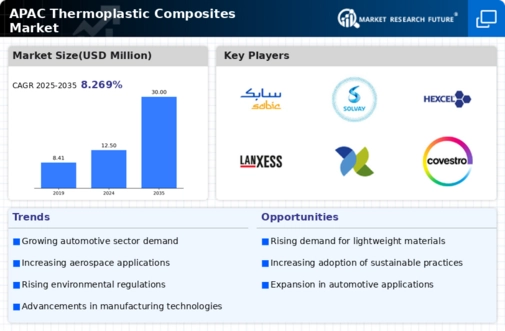The APAC Thermoplastic Composites Market has been experiencing remarkable growth due to the increasing demand for lightweight materials across various industries, including automotive, aerospace, and construction. The competitive landscape of this market is characterized by the active participation of prominent manufacturers as well as emerging players. Key strategies employed by these companies include product innovation, strategic collaborations, and geographical expansion to enhance their market share. Additionally, sustainability and environmental concerns are driving companies to adopt eco-friendly manufacturing processes, thereby reshaping the competitive dynamics within the region.
By leveraging advanced technologies and optimizing their supply chains, companies in the APAC Thermoplastic Composites Market are focusing on delivering durable and high-performance composites, positioning themselves advantageous in the competitive arena.
SABIC holds a significant presence in the APAC Thermoplastic Composites Market, largely attributed to its strong emphasis on innovation and advanced material development. With a robust portfolio of specialized thermoplastic composite materials, SABIC has established itself as a leader by consistently meeting the diverse needs of industries such as automotive and aerospace. The company's strengths lie in its commitment to research and development, which has led to the creation of high-strength and lightweight solutions that cater to specific customer requirements.
Moreover, SABIC's extensive distribution network in the Asia-Pacific region allows it to efficiently serve its clients and respond to market demands promptly. Its strategic partnerships and collaborations with local and regional companies further bolster its competitive positioning in the market, enhancing its ability to lead in sustainable composite solutions.
Solvay is another key player in the APAC Thermoplastic Composites Market, well-known for its extensive range of advanced materials that cater to various industrial segments. The company offers a comprehensive array of thermoplastic composite solutions designed to optimize performance and reduce weight while maintaining exceptional durability. Solvay's notable strengths include its commitment to technological advancement and sustainability, ensuring its products meet regulatory and environmental standards. The company has strategically positioned itself through key partnerships and collaborations across the Asia-Pacific region, which have propelled its market presence significantly.
In addition to its innovative product offerings, Solvay has engaged in mergers and acquisitions to expand its capabilities and enhance its portfolio, showcasing its growth-oriented strategy in the competitive landscape of thermoplastic composites in APAC.
With a focus on delivering high-quality and reliable materials, Solvay continues to reinforce its status as a formidable player in the region.
























Leave a Comment